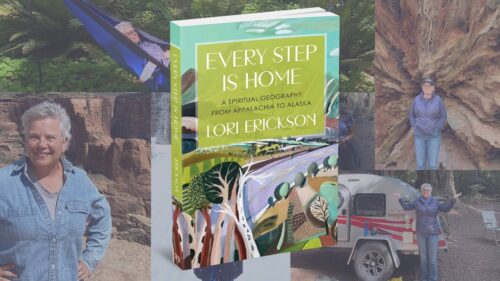

EVERY STEP IS HOME: Spiritual geography from Appalachia to Alaska. By Lori Erickson. Louisville, KY: Westminster John Knox Press, 2023. 211 pages.
When I travel, I’ve been known to visit churches, especially cathedrals, to such an extent that my spouse will complain when I want to visit another church. Perhaps the reason I want to do this has more to do with the spiritual dimensions of these sites than the architecture and aesthetics involved. Though, as a church historian, many of these sites have historical interest. At least that’s my rationale for wanting to visit such sites. We all have reasons for choosing the sites we visit when we travel. We may even have an interest in the spiritual dimensions of such sites. They do not have to be churches or other religious buildings such as mosques, synagogues, and Temples, for them to have spiritual dimensions. They could be volcanoes or lights in the sky. What is often needed for the traveler to appreciate the spiritual dimensions of a site is a guide, someone who has a special interest in spiritual journeys.

Robert D. Cornwall
The author of Every Step Is Home: A Spiritual Geography from Appalachia to Alaska, Lori Erickson, is just the person to help readers discern and discover the spiritual dimensions of geography, especially those sites that lie beyond the usual religious buildings (the ones I like to visit). Erickson is by profession a travel writer who has a special interest in spiritual journeys. Every Step Is Home is the second book by Erickson that I read and reviewed. I previously reviewed her book Near the Exit: Travels with the Not-So-Grim Reaper (Westminster John Knox Press, 2019). In that rather intriguing book, Erickson invites the reader to join her on a journey to places where death is lifted up in some way, and which helped her come to grips with death. While Erickson is a deacon in the Episcopal Church and thus a committed Christian, she has what one might call esoteric spiritual interests that take her beyond those cathedrals that I love visiting. What is true for Near the Exit, which took her to places as far-flung as the pyramids of Giza and encounters with the Māori of New Zealand, this book stays closer to home. This time the focus is not on sites necessarily connected with death.
The subtitle of Every Step Is Home reveals the context for this conversation about spiritual journeys. In this book, we encounter “A Spiritual Geography from Appalachia to Alaska.” Most of the journeys and encounters described in this book occurred either during the COVID pandemic, which made travel challenging, or shortly thereafter.
In her Prologue, which focuses on a set of effigy mounds in her own Iowa backyard, Erickson confesses that as “a travel writer who specializes in holy places, I’m embarrassed to say that for most of my life I’ve ignored this spiritual treasure in my own backyard” (p. 1). That spiritual treasure would be “The Marching Bears of Iowa,” a set of effigy mounds standing on a bluff overlooking the Mississippi River. One needn’t be a travel writer focusing on spiritual things to ignore or miss what is close at hand. Perhaps it’s something like a pandemic that limits travel to take stock of what is close at hand. As for the spiritual dimensions of these mounds, which failed to catch her attention until COVID forced her to connect with spaces close to home, she discovered that the Marching Bears, which form part of the Effigy Mounds National Monument in Iowa, bears signal that “the spiritual path calls for subtlety and discernment.” That is, “just as it’s easy to overlook these mounds, it’s easy to miss the sacred that threads through all of life” (p. 2). She speaks of having a restless spirit that causes her to feel like organized Christianity, an entity she doesn’t wish to leave behind, can feel “like a room with its windows shut” (p. 2). For that reason, she seeks to explore those places like ancient effigy mounds that speak of spiritual things, even if they’re not rooted in her own Christian faith.
Keeping in mind that just as she began work on this book the COVID pandemic hit, curtailing her ability to travel, the focus on sites in the United States, which she could reach with the camper that she and her husband Bob used for traveling, made it possible to get to places that are rather out of the way, places like Chaco Canyon in a remote part of New Mexico. There are places described here that did require other forms of travel. These include a visit to Alaska to view the Northern Lights, as well as a trip to Hawaii so they could visit sites connected with Pele (volcanoes).
Much of the book centers on sites such as the Effigies of Iowa, the buildings constructed by an ancient people in Chaco Canyon, New Mexico with an apparent interest in astronomy, and the effigy mounds in Ohio, including the Serpent Mound, all of which have spiritual components. There are also reflections on trees that emerged from a visit to the Redwoods in California (the Redwoods are quite magnificent, so I can understand how they might have spiritual significance), as well as a reflection about the spiritual dimensions of water, as revealed in hot springs in the mountains of Oregon (I found this interesting since I grew up in Oregon, and while I know of the geothermal potential found there, I did not know that so many hot springs existed In Oregon that might have spiritual significance). We visit a cave in Tennessee, which contains a variety of ancient drawings and etchings that date to a period extending from 900 to 1600 CE. You might ask why we should be interested in such places as a dark cave with ancient drawings. Erickson answers this question, writing that “being in the cave made me realize how almost all of my most significant spiritual experiences have had a physical trigger.” Then she piques my interest when she adds that “stepping inside a cathedral, for example, and being overwhelmed by the echoing interior space.” She then mentions other spiritual triggers such as standing at the edge of a canyon and “watching the light play across its peaks and valleys,” or “walking on a beach and hearing the waves crash rhythmically” (p. 125). She also speaks of animals, such as the Buffalo (Bison) of South Dakota. A visit to Custer State Park, and a Buffalo Roundup, allows her to explore how animals figure in spirituality. That is true even in Christianity, which has more echoes than we might imagine. Remember that Jesus is often referred to as the Lamb of God and the Holy Spirit is symbolized by a dove.
While I still love my cathedrals, which have a very Christian expression of spirituality, Erickson’s book Every Step Is Home serves as an invitation to open ourselves to those physical triggers, that invite us to dive deeper into the ways of the Spirit. Most of the sites, perhaps all of them discussed here do not have specific Christian connections. But can we not learn to experience deep spirituality from our encounters with nature and the creations of ancient peoples, especially here in the United States/North America? Native American spirituality has much to teach us, especially when it comes to valuing the wisdom offered by nature. Nevertheless, Erickson writes that on their departure from Chaco Canyon, knowing that it was unlikely they would return due to the remoteness of the place, she reflected on the fact that “some places you visit but shouldn’t remain, because they’re part of your path but not your destination.” Here is an important word for us about that organized religion that exists for us— “maybe that’s why we need our local churches and synagogues and mosques, the places where we put down spiritual roots. A kind of alchemy can occur there too, transformations created by ordinary human interactions, of having to put up with people who irritate you and be with them when they’re dying of meeting budgets and cleaning floors and all the other details that go into sustaining a community of faith” (p. 200).
There is wisdom in this concluding word. Pilgrimages take us to places where we experience the divine, and yet they generally are not places we stay. Ultimately, we return to those spiritual places that serve as our spiritual homes, homes that generally have institutional dimensions. Both the pilgrimage and the home are necessary. It’s often the pilgrimages to cathedrals and a grove of trees that can help us keep that spiritual balance. As she notes in her closing sentence: “Just keep your heart open and the spirit will appear” (p. 201). With the guidance offered here, we can open ourselves to the Spirit as we explore sites near and far, some of which Erickson has revealed to us.
This review originally appeared on BobCornwall.com.
Robert D. Cornwall is an ordained minister in the Christian Church (Disciples of Christ). Now retired from his ministry at Central Woodward Christian Church (Disciples of Christ) of Troy, Michigan, he serves as Minister-at-Large in Troy. He holds a Ph.D. in Historical Theology from Fuller Theological Seminary and is the author of numerous books including his latest “Second Thoughts about the Second Coming: Understanding the End Times, Our Future, and Christian Hope” coauthored with Ronald J. Allen. His blog Ponderings on a Faith Journey can be found at www.bobcornwall.com.
